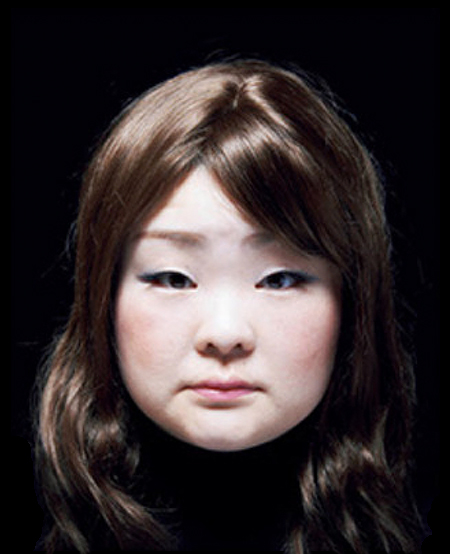
Continuing through April 9, 2016
Tomoko Sawada is a Japanese artist whose self-portrait works are concerned not only with identity and personality but the relationship between a woman's inner and outer image. She rose to fame with her project "ID400" (1998), in which she presented large grids of black and white photographs created in photo booths. Each time Sawada visited the booth she was dressed and made up differently. She sat in the chair and pushed the button. Out came a square image containing four identical passport size photographs. Sawada composited the grids of four into large-scale montages. By the end of the project she amassed 400 photographs, which she presented in different gridded configurations. What is remarkable about this project is how different she appears and how by changing hairstyle, (she often wore a wig), makeup, clothing, expression and attitude, how many different personas an individual can become.
In this regard, Sawada is as much a performance artist as she is a photographer. Sawada does not become someone else to the extent that photographers Yasumasa Morimura and Cindy Sherman do in their work. Rather she casts herself in the role of model, changing her appearance in myriad ways for her different projects. In her work she parodies conventions and familiar photographic formats like fashion photographs and wedding and school portraits to simultaneously examine the role of femininity in Japan and to expose stereotypes and assumptions about racial identity.
In the “OMIAI” (2001) series, Sawada visited a professional portrait studio portraying herself as a candidate for an arranged marriage dressing in the formal attire the potential bride would wear. As in her “ID400" series, different costumes and makeup transforms her into a diverse range of personalities. In "School Days" (2004) Sawada became the myriad faces of schoolgirls posing for a class picture. In “Costume” (2003) she was photographed in costume on location — as for example, a policewoman or a proprietress — taking on the persona of each woman in the midst of doing her job.
In the new series that comprises the current exhibition, "Facial Signature," Sawada transforms herself 300 times simulating the varied appearances of Japanese, Chinese, Korean, Taiwanese and other East Asian women. According to Sawada the genesis of the project grew out of an epiphany she had in New York City. She realized her friends did not necessarily see her as Japanese but as any one of a number of East Asian ethnicities. This led her to consider the “intuitive process by which people achieve cognition of true or false archetypes.” She set out to discover what she could or could not become.
As with her previous projects, “Facial Signature" explores identity, class, stereotypes, conformity, similarities and differences through a suite of images. The photographs are frontal and direct. They are close-cropped depictions of Sawada’s head from the neck up, against a black background. The 300 framed photographs are presented as large grids expanding across the walls of the gallery. Each image is an (approximately) 8 1/2 by 11 inch photographic print set into a black frame that matches the background color of the photograph. Looking from image to image, as well as flipping through the 300 pages of an accompanying artist's book, there is a sameness in the presentation — centered face filling the frame, looking straight ahead. There are also noticeable differences that emerge as Sawada is transformed into other East Asian ethnicities.
A small mole, the color and style of the hair (Sawada wore a variety of wigs to make these photographs), the separation between the hairs of the eye lids and lashes, the hue and contour lines of lipstick, the slant of the eyes and the puckering of the mouth distinguish one image from another. While Sawada presents a wide range of East Asian archetypes, what one takes away is sameness. Sawada's project emphasizes that a face is a signature that signals one's identity and that minute changes to a face blurs distinctions between race. In her own words: "We human beings share 99.99999% of the same genes. All of us — despite having different types of so-called 'added cultural values' — such as nationality, race, religion, and language — are by nature and essence equal to one another."
Published Courtesy of ArtSceneCal ©2016
